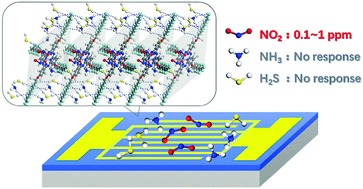当前位置:
X-MOL 学术
›
New J. Chem.
›
论文详情
Our official English website, www.x-mol.net, welcomes your feedback! (Note: you will need to create a separate account there.)
Highly selective room-temperature NO2 sensors based on a fluoroalkoxy-substituted phthalocyanine†
New Journal of Chemistry ( IF 3.3 ) Pub Date : 2018-03-19 00:00:00 , DOI: 10.1039/c8nj00622a Qiqi Sun 1, 2, 3, 4 , Weigang Feng 1, 2, 3, 4 , Pu Yang 1, 2, 3, 4 , Guoqiang You 1, 2, 3, 4 , Yanli Chen 1, 2, 3, 4
New Journal of Chemistry ( IF 3.3 ) Pub Date : 2018-03-19 00:00:00 , DOI: 10.1039/c8nj00622a Qiqi Sun 1, 2, 3, 4 , Weigang Feng 1, 2, 3, 4 , Pu Yang 1, 2, 3, 4 , Guoqiang You 1, 2, 3, 4 , Yanli Chen 1, 2, 3, 4
Affiliation

|
A new n-type 2(3),9(10),16(17),23(24)-tetrakis(2,2,3,3,4,4,5,5,6,6,7,7,8,8,8-pentadecafluorooctyloxy)phthalocyanine H2[Pc(OCH2(CF2)6CF3)4] (1) is designed and synthesized. The introduction of electron-withdrawing pentadecafluorooctyloxy chains onto the peripheral positions of the phthalocyanine macrocycle successfully realizes the n-type organic semiconducting nature of the compound. Two kinds of films are fabricated by simple drop-casting (DC) and vacuum deposited (VD) methods, respectively. Examination by spectroscopic methods and morphology observation revealed that H2[Pc(OCH2(CF2)6CF3)4] molecules in the DC film adopt the J aggregation mode, whereas those in the VD film adopt the H aggregation mode, with the increasing molecular stacking order of DC < VD films. Moreover, these two types of films are used for low concentrations of NO2 detection. The highly sensitive n-type responses to NO2 gas in the range of 100 ppb to 1 ppm are obtained within a dynamic exposure period of 1 min at room temperature. Depending on the favorable hydrogen bonding between the analytes and the fluoroalkoxy groups or phthalocyanine core of compound 1, excellent selectivity for electrophilic NO2 against electrophobic NH3 and H2S is achieved successfully. The responses of the compound in the DC and VD films are all linearly correlated to the NO2 concentration from 100 ppb to 1 ppm with a significant increase in sensitivity from 7.54% ppm−1 for the former to 12.05% ppm−1 for the latter. The present work not only implies the great potential of the fluoroalkoxy-substituted phthalocyanine derivatives in the field of chemical sensors, but more importantly provides a new strategy through the elaborate molecular design combined with a suitable film fabrication technique to obtain ultrasensitive and selective sensors for the detection of trace amounts of gas.
中文翻译:

基于氟烷氧基取代的酞菁的 高选择性室温NO 2传感器†
一个新的n型2(3),9(10),16(17),23(24)-四(2,2,3,3,4,4,5,5,6,6,7,7设计并合成了8,8,8,8-十五碳五氟辛氧基)酞菁H 2 [Pc(OCH 2(CF 2)6 CF 3)4 ](1)。将吸电子的十五氟辛基氧基链引入到酞菁大环的外围位置上,成功地实现了该化合物的n型有机半导体性质。分别通过简单的压铸(DC)和真空沉积(VD)方法制造了两种薄膜。光谱学检查和形态观察表明,H 2 [Pc(OCH 2(CF 2)6 CF 3)4 ]分子在DC膜中采用J聚集模式,而VD膜中的分子采用H聚集模式,随着DC <VD膜的分子堆积顺序增加。而且,这两种类型的膜用于低浓度的NO 2检测。在室温下1分钟的动态暴露时间内,可获得100 ppb至1 ppm范围内的对NO 2气体的高度敏感的n型响应。取决于分析物与化合物1的氟烷氧基或酞菁核之间的有利氢键,亲电子NO 2对疏水性NH 3和H的选择性极好2 S被成功实现。DC和VD膜中化合物的响应均与NO 2浓度从100 ppb线性线性相关,至1 ppm,灵敏度显着提高,从前者的7.54%ppm -1到后者的12.05%ppm -1。 。本工作不仅暗示了氟烷氧基取代的酞菁衍生物在化学传感器领域的巨大潜力,而且更重要的是通过精细的分子设计与合适的膜制备技术相结合,提供一种新的策略,以获得用于该传感器的超灵敏和选择性传感器。检测痕量气体。
更新日期:2018-03-19
中文翻译:

基于氟烷氧基取代的酞菁的 高选择性室温NO 2传感器†
一个新的n型2(3),9(10),16(17),23(24)-四(2,2,3,3,4,4,5,5,6,6,7,7设计并合成了8,8,8,8-十五碳五氟辛氧基)酞菁H 2 [Pc(OCH 2(CF 2)6 CF 3)4 ](1)。将吸电子的十五氟辛基氧基链引入到酞菁大环的外围位置上,成功地实现了该化合物的n型有机半导体性质。分别通过简单的压铸(DC)和真空沉积(VD)方法制造了两种薄膜。光谱学检查和形态观察表明,H 2 [Pc(OCH 2(CF 2)6 CF 3)4 ]分子在DC膜中采用J聚集模式,而VD膜中的分子采用H聚集模式,随着DC <VD膜的分子堆积顺序增加。而且,这两种类型的膜用于低浓度的NO 2检测。在室温下1分钟的动态暴露时间内,可获得100 ppb至1 ppm范围内的对NO 2气体的高度敏感的n型响应。取决于分析物与化合物1的氟烷氧基或酞菁核之间的有利氢键,亲电子NO 2对疏水性NH 3和H的选择性极好2 S被成功实现。DC和VD膜中化合物的响应均与NO 2浓度从100 ppb线性线性相关,至1 ppm,灵敏度显着提高,从前者的7.54%ppm -1到后者的12.05%ppm -1。 。本工作不仅暗示了氟烷氧基取代的酞菁衍生物在化学传感器领域的巨大潜力,而且更重要的是通过精细的分子设计与合适的膜制备技术相结合,提供一种新的策略,以获得用于该传感器的超灵敏和选择性传感器。检测痕量气体。



























 京公网安备 11010802027423号
京公网安备 11010802027423号